Raising Goats To Be Healthy & Productive
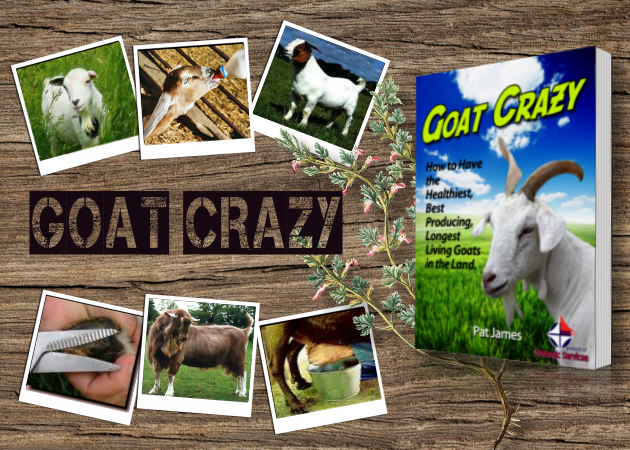
Whether you are raising goats as pets or are goat keeping for profit, learn how to keep goats with these free tips for beginners!
The information in this section on keeping goats for profit or pleasure is taken from a goat keeping report that is available in other places online, so the information is not exclusive to my site, but has some good basic goat care tips, so I'm adding it here for you to start your initial goat care learning.
But to get your hands on the ultimate keeping goat guide you will need to check out my exclusive goat book "Goat Crazy" - the full description of the essential goat care information contained in this comprehensive manual is at the bottom of this page.
If you have already heard about it and want immediate access you can buy it online here as a .pdf ebook download (with a bonus recipes book), or get it on Amazon in both a Kindle download or as a paperback printed Book.
Those are the only ways to get this totally comprehensive book with 90+ pages of comprehensive goat care information to cover all aspects of keeping goats.
But first, in this report below you will find some simple tips to answer some of your basic goat care questions.
Raising Goats Guide 101
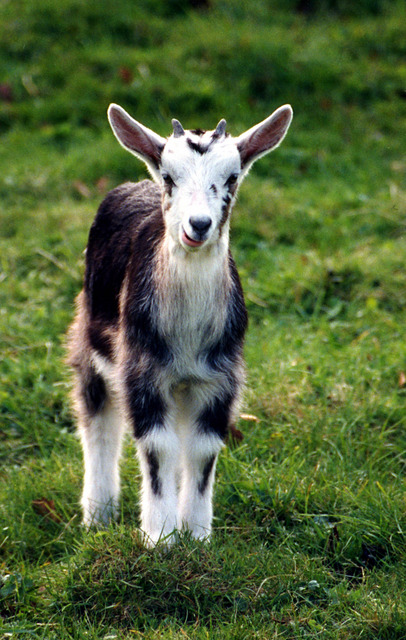
There are different types of goats that are raised for companionship, meat, milk, wool, and many other purposes.
Dairy, Nigerian dwarf, Boer, Cashmere, Pygmy, and Mountain goats are some of the major types of goats that you will find at various part of the world.
· Find out as much information as you can about taking care of goats.
Get some goat books, research online and find some people who have or who are currently raising and taking care of goats for a living.
· Consult with more than one breeder. See which one would give you a good deal on a goat.
Find out about vaccinations and other things you need to know before you seal the deal.
· Make preparations for your goat prior to purchasing one and bringing it home.
They will need a secure shelter, water and food.
· From day one, you will have to put your best foot forward with taking care of your goat.
Try to stick to the same daily schedule. Spend time with the goat so that they can get used to your presence.
· Have a regular schedule that involves preventive maintenance that includes hoof trimming and maintain their coat.
Their coat should always be cleaned and well groomed.
· If you don’t do anything else, always remember that goats are more content when they have company (other goats).
They don’t like to be alone.
· Do not breed the goats past ten years old. If you do, they won’t live as long.
The average life span is about 12 years, but some of them can live longer, up to 18 years.
This is because they stopped breeding when they were supposed to.
Breeding can take a lot of energy out of a goat.
By the time they decide to settle down, they don’t have much energy left.
· When you put up fencing, make it so where the goat cannot easily access getting out.
If you have easy access, the goat will be able to get out of the fence and roam elsewhere.
· If you have trees and bushes on your property, keep the goats away from them.
They like trees and bushes. If they get near them, you won’t have them much longer.
You won’t have to prune them yourself because they will do it for you.
· Don’t give goats more hay that what they will eat.
It is part of their makeup to eat less than what you give them.
Study them to see how much they eat. Then you can adjust your portions accordingly.
· Don’t be scared of your goat.
There are times when they are aggressive. They will know when you are timid and can take advantage of that.
Once they know that you can play their game, they will buckle down and act right.
· Your first goat should be a female (doe) goat.
They are easier to deal with than male (buck) goats. Male goats require more energy and more experience for you to handle.
They can be aggressive; if the male is a billy goat, they tend to emit a strong odor that you may not be able to handle right away.
· Keep your goat secured in the event of predators, such as a dog or a coyote.
If they should get violated by one of them, check for injuries and take them to the veterinarian as a precaution.
About Nubian Goats
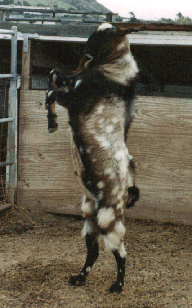
Nubian goats (Anglo-Nubians) are originally from North Africa and the Middle East.
However, they were developed in England. They like to live in hot regions and can be used for meat and milk.
Nubian goats are large for both females and males. The females weigh about 135 lbs. and the males weigh about 175 lbs.
You won’t have many issues about taking care of these kinds of goats on your farm.
However, you will still need to know what to do if you plan to take care of them.
Nubian goats should always have lots of clean water. The container that the water is in should always be clean as well.
You can use a bucket or a trough to keep the water in. These goats can take in two to five gallons of water daily.
If they are in a warm area they can probably drink more. Or if they are larger, they can also drink more water than what’s recommended.
Nubian goats eat alfalfa and clover hay. Make sure that the hay is of good quality.
They also consume goat feed that is concentrated. With this food, they should also have a loose mineral or salt mix.
Nubian goats need to have shelter, so you will have to build one for them. Make sure that this shelter has a roof to keep them from getting wet.
They don’t like to get wet and they can get sick if they have to stand in the rain. If you paint the shelter a certain color, use non-toxic paint.
Goats like to chew on the material. So if you use non-toxic paint, it won’t bother them.
The area where the Nubian goats are sheltered should be secured.
This can help to keep them from leaving the premises and to keep away animals such as coyotes that can get in and harm them.
The fencing should at least be four feet in length and use solid posts that won’t easily come out of the ground.
Maintain the yard and shelter where the goat(s) reside. You must remove the manure and used bedding to change it out for clean ones.
Keeping their area clean and healthy will help the goats from contracting illness or diseases. The old manure can also be used for fertilizer.
Nubian goats should have their hooves trimmed every three months to keep their feet from rotting. You can use a hoof trimmer and hoof file to do this.
Get your Nubian goat vaccinated every year. Continuously be on the lookout for lice and worms that can make them ill.
Nubian goats don’t like to be alone so you will need to have more than one goat for them.
During the winter season, give your goat warm water so that they will drink more of it.
In order to keep the flies away, use flytraps and fly strips that are not toxic.
This is so that you can keep their area free of flies as much as possible.
If flies come in contact with the goats, they can cause harm to them by way of illness.
About Mountain Goats
There are various types of goats and mountain goats are one among them.
Mountain goats found exclusively in North America are renowned with the name Rocky Mountain goat.
Mountain goats have large hoofs and are from different genus and renowned as the goat antelopes.
In one bound, they can jump up to twelve feet’s that shows how powerful they are! Their balance depends on the two-toed cloven hooves.
Mountain goats have unique beards.
Their long white coats are warmer and protect them in a big way from mountain winds as well as severe cold temperatures.
They shed their coats during summer season. Both nannies and female goats have scintillating pointed horns.
Males use their horns to fight with opponents during mating season. Billies’ stays alone or with other counterparts.
Nannies, for the most part of a year stay with the herds having strength of around twenty, including their kids.
During spring, nannies give birth to kids.
Billies are around 175 centimeters long, and have height of 122 centimeters.
The nannies have length of around 145 centimeters and height of around 92 centimeters.
Billies weigh around forty-six kilograms to hundred and two kilograms. Nannies weigh ten to thirty percentages lighter than Billies do.
Mountain goats survives in rocky mountain by consuming grasses, plants, mosses as well as other vegetation seen in alpine valley.
Mountain goats have a lifespan of around twelve to fifteen years.
About Pygmy Goats
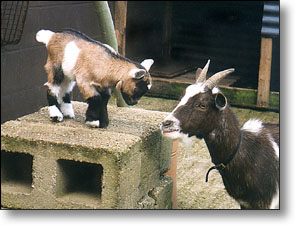
Pygmy goats are great pets that you can take care of on your property. You will need to have two.
As you know by now, goats do not like to be alone. They like to be around other goats.
These goats can also be used for getting milk and meat. The smaller they are, the easier they are to take care of.
Pygmy goats are originally from Africa. They came to the U.S. in the 1950s.
They were originally used to get rid of weeds in the yard.
Because they are friendly and playful, they become popular and more people wanted them as a pet.
These goats look like regular goats with the exception of their legs.
They are sturdier and they are also shorter than regular goats.
They get their horns removed just like other goats. Pygmy goats come in black and caramel colors.
For the most part, you will find black ones that have black legs or ones that are just completely black all over.
A full grown pygmy goat usually weighs no more than 70 lbs.
They are year round breeders and have many children that can weigh up to 4 lbs. each. They usually have between one to three kids.
These goats should be clean at all times and will not eat from dirty dishes. They prefer clean water.
Keep the water away from the ground. These goats will eat roughage that consists of legume and sweet feed.
When they are still babies, their bodies are not strong enough for them to eat this kind of food.
Pygmy goats help their owners a lot. They will eat weeds and leave the grass for other cattle on the ranch.
They will also make noise if they spot a stranger on their property that could cause harm to the rest of the livestock.
Pygmy goats are cute animals and they are affectionate. You can rub and scratch their snouts.
They can also be in the same company with dogs and cats.
Pygmy goats need to be fenced in. It should be five feet or more in order to keep out dogs or other predators who may roam around.
Make a platform for the goats the sleep on. You can use an old door to do this.
If they eat from hay feeders, install them away from the ground. Having the feeder elevated can keep the parasites away.
Feed them grain mix. You can make it or purchase it. They can also eat alfalfa supplement that has grain in it two times every day. If their food falls on the ground, they will not eat it.
The pygmy goats should get their hooves trimmed every four months.
If the pygmy goats are more than six months old, get the worms out of them. You can do this once a year.
Pygmy goats need boosters and vaccinations every year. Consult with your vet as to which ones they should receive.
Pygmy goats are active, so you have to provide them with a place to play as well as something to play with.
As with other goats, keep the pygmy goat’s coat groomed at all times. They enjoy this process because they like to bond with their owners.
If you are taking care of two pygmy goats, you can house them in a dog house. However, you can always get something larger so that there will be plenty of room.
Having a larger facility is also a good idea if there will be mating going on.
Pygmy goats can be milked and can provide up to a half-gallon of milk daily.
About Angora Goats
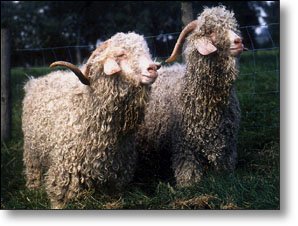
Angora goat is a Turkish goat from the region of Angora.
Historians found the mentioning about this goat during Moses era.
Around 1554, Roman emperor, Charles fifth, took Angora goat to the Europe.
Mohair is the fleece taken from angora goats.
Every year an individual angora goat produces hair of around five to eight kilo grams.
Due to the hair density, they are greatly susceptible to various external parasites.
Sales of mohair account for majority of income from the Angora goats herds.
Angora goats are not that active like other dairy goats.
They, with their browsing abilities feed on food from branches as well as leaves of trees.
Angoras are suitable for clearing bushes as well as weed, as they feed on those stuffs.
Billies weighs around eighty-five to hundred and twenty-five pounds, while nannies weigh around seventy-five to hundred pounds.
Angoras need nutritional food, as major part of it is required for the growth of mohair.
Proper sheltering is required for these goats to counter the cold after shaving of mohair.
In olden days, there where only white Angoras, now they are available in colour shades like brown, red, black etc.
The breeding period of Angoras is between fall and winter. Angoras have life expectancy of around 12 years or more.
People raise Angoras for their mohair as there are industries based on mohair.
Due to the mohair requirement, this breed has its presence across the world now.
How to Milk a Goat
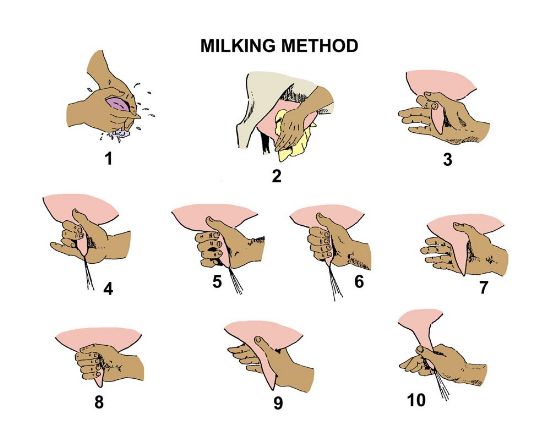
· Give the goat a bucket of feed.
Start rationing at ½ cup and add more at a slow pace.
Keep going until you have gotten to the amount that you are supposed to be at.
· Place the goat’s head in the milk stand.
Or you can secure the goat in a corner and make them be still.
· Wash their udder using a mild bleach and soap mixture.
Thoroughly dry the udder with a clean paper towel.
· Take your right thumb and your forefinger and create a ring around the teat.
This should be done at the top where the udder is.
Squeeze the top of the teat and the udder together.
Take your middle, ring and pinkie finger and squeeze the top part off.
Using the teats, squirt out a few sprays of milk into a cup.
Look at the milk to see if you find abnormalities such as stings or blood.
If milk comes out then you are doing it right.
If not, then you are doing it incorrectly.
The top of the teat must be clinched.
You also have to make sure you are giving the teat and the udder a firm squeeze.
Repeat the process with your left hand.
Continue to squeeze out milk until you can’t get any more.
However, if you think there is more in there, continue trying.
You can even massage the udder to get more milk to come out.
· After you’re done, spray the udder openings using beta dine.
This prevents the doe from getting a disease or disorder.
This also prevents bacteria from getting in the udder openings.
· The goat’s milk can be stained with a coffee filter or a paper towel.
Staining is when you remove particles such as debris, hair or dirt from the milk of the goat.
Put the milk in ice water and allow it to chill.
· You will need to pasteurize the milk using a double boiler.
Heat it at 165 degrees Fahrenheit for only 15 seconds.
Remove it from the stove and place it back in the ice water.
Here are some tips that you can use in order to get a good batch of goat’s milk:
· You should talk to your goat while you are milking her.
Be nice to her and talk to her in a nice tone.
The goat will know that you really care about her and will want to provide you with plenty of milk.
Don’t’ feel like it’s a burden when you are milking.
You should enjoy doing this.
Not only will you get more pleasure out of milking the cow, but you’ll get what you need in the process.
In order to get good milk, feed your goat plenty of hay that has a lot of protein in it.
Make sure to feed your goat food with plenty of grains, roughage and mineral mix.
The does should be separated from the bucks during the milking process.
Otherwise, the milk will not have a good taste.
In order to keep the milk fresh and tasty, chill it as soon as you can.
How to Breed Goats
Breeding a goat is something that you need to have time to do.
You can’t just do it once and think that magic will happen the first time around.
This is a serious undertaking, and you have to be willing to take time and put in a lot of work to make it happen.
When a female goat is in heat, they will wag their tail and stay close to the buck if there is one nearby.
The female goat makes more noise. During this time, they are not very hungry and they have a decreased production in milk.
The female goats are usually sexually active and fertile between September and March.
They can be fertile up to three days. If the female goat has not mated with a buck by then, they will be fertile for three weeks.
· Your doe must be capable of breeding.
They must be in good shape and not be too skinny or too fat.
· Look for a buck that can be a potential breeding mate for the doe.
See if you can find one that is compatible with the doe that you have.
Check to see if his mother and other female does that are related have good udders.
The buck and the doe should be of the same breed.
If you are unsure about how to go forward, ask some goat owners who have experience in breeding goats.
· There are two ways that goats are bred: natural breeding and artificial insemination.
Natural breeding cost less and is more likely to get quicker results. Just make sure that the buck is suitable for the doe.
If you can’t find a suitable buck, then the doe will have to be artificially inseminated.
The latter method costs more and there is no guarantee that she will get pregnant.
· Both goats should be healthy and eating a well-balanced diet.
They should also be in shape to do this.
If it’s done naturally, the process will take a lot out of them.
Other things that should be done include getting rid of worms and trim their heels.
They should be administered a booster shot about two months prior to the breeding process.
· You doe will go into heat and start wagging their tail and not wanting to eat.
They will get restless and mount other goats. She will also allow other goats to mount her.
Her behind will be red and she will experience a discharge of mucous from her vagina.
They usually remain in heat for at least three weeks.
· At the beginning of the heat cycle, the doe should breed early.
After they have reached the heat cycle, they will ovulate every 36 hours after the cycle has begun.
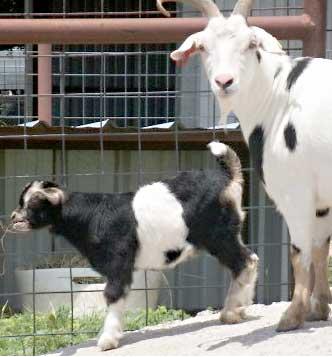
When a female goat is with child, their pregnancy (gestation) lasts about five
months or 150 days.
When it’s time for them to give birth, they will either have one goat. Or they may have twins or triplets.
The birthing process is called “kidding”. When they give birth, it is usually an easy process without many complications.
If there are complications, they are very few.
The female goat consumes their placenta after birth because it contains nutrients they need to stay healthy.
Eating their placenta also helps the control of their blood flow.
Bucks who may be
looking for them may not find them as easily because the scent of the female’s
birth is light.
After the kid is born, they will remain in a safe place. Their mother will go off for a while to
feed.
She will get the kid when she
returns and starts to nurse. Once they
have finished that, they will start to produce milk. This is called freshening”.
The female goat can produce six pounds of milk daily while she has milk in her system.
The kid gets her milk until they
can go on their own. That can take up to
three months.
Female goats (does) can live up to about 12 years on an average span. Sometimes the female goats have a short life
span due to giving birth.
· Goats should breed until they turn 10 years old.
After that, they should stop. It can add more years to their life.
Those that breed after 10 years are subject to see their lives cut short.
Breeding can take a lot out of a goat, hence the strongly recommended 10-year limit.
If the does stop breeding by the time they’ve turned 10 years old, they usually live longer than 12 years old.
How to Take Care of a Newborn Goat (Kid)
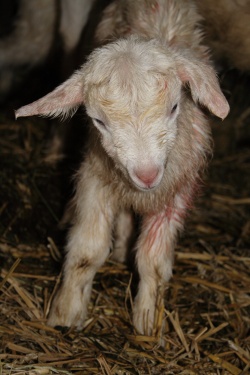
A brand new goat has just been born to its nanny.
This is the beginning of a new life for you and the newborn goat.
There is plenty for you to do, starting with removing the wet and cold goo that they come into the world with.
The goat’s head will be wrapped in a membrane and it may not be able to breathe at first.
Unlike a regular human baby delivery, this is a normal process. Don’t freak out or overreact because they eventually come to life.
As with a human baby, the umbilical cord should be detached.
If it does not do that with the newborn goat, use two pieces of thread and create a knot around the cord.
Use a pair of sharp scissors to cut between the knots.
Clear the membranes by using a clean cloth or a towel.
You will usually find the membranes on their nose (nostrils) as well as their head.
Take another clean cloth and wrap it around your hand. Place it inside the newborn’s mouth to remove debris and mucous.
The goat has to be stimulated. Gently stroke the sides of the goat.
This not only helps with stimulation, but it also helps to get their blood pumping.
Soon afterwards, you will be able to hear them breathing. Keep the newborn warm and dry with clean towels.
Place a bulb syringe into their throat and suck out secretions or tissues that were left from before.
Close one nostril by pinching it and place the syringe into the open nostril. Do the same thing with the other nostril.
If you don’t have a bulb syringe, you can use a strand of clean hay into their nose.
Make jiggling movements with the hay until the baby goat sneezes.
Once they sneeze, any excess that was left should be gone from the nasal cavities.
Get a container and fill it will iodine solution (7%). Put the end of the goat’s umbilical cord inside of the container.
With the open end of the container, press it against the newborn’s stomach and cover the entire area with the iodine with the exception of the newborn’s genitals.
Take the teats of the nanny and squeeze them. You want to get rid of any obstructions and get milk to start coming out.
Place the newborn (or kid) close to their mother. You are working on feeding them for the first time.
To get them adjusted, put a tiny bit of milk on the kid’s lips. If they don’t want it, give them a bottle.
Once they feel like suckling from their mom, they will try again.
After they have been in the world for about an hour, the newborn should have no more than eight ounces of milk.
After that, allow the mother to take care of their child.
Give the milk to the baby goat and place it in a small container.
You will need to collect colostrum, which is the first milk that you will get from them.
Baby goats need this because it helps to keep them healthy.
See if the baby goat has gotten accustomed to nursing from their mother.
If not, the baby will have to be bottle fed four times every day. The goat’s milk should always be fresh.
It is extremely important that your kid gets colostrum.
This first milk has plenty of carbohydrates, proteins and nutrients that your kid will need in order to stay healthy.
It also contains antibodies, which your kid will need for protection.
Since the kid’s lining in their digestive system adjusts within a day after they are born, the antibodies are needed prior to the adjustments being made.
The baby goat should be fed regularly every day. They should be fed at least four times daily.
Their stomachs are small and they need plenty of nutrients.
They will be assured of regular feedings as long as they stay with their mother.
There may be times when you will have to bottle feed them. You can use a baby bottle and cut a small X in the tip of the nipple.
They should always be fed goat’s milk; however, raw cow’s milk will suffice when goat’s milk is not available.
With the latter, three tablespoons of corn syrup is needed for each gallon.
In the event they are not used to cow’s milk, be patient and let them get used to drinking it.
The baby goat should always sleep in a warm and dry area.
Make sure there is enough covering to prevent the goat from being in the sun and the rain.
Ensure that the area is not drafty. For their bedding, use straw.
You need to use a material that does not stick to your baby’s coat.
You may need a heat lamp if the baby goat was born in the early spring season or the late winter season.
The heat lamp will keep the baby goat warm.
Using a warm and damp cloth, clean the kid’s face, ears and back legs every day.
Look on the hooves for debris and remove it. Make their coat look good by using a soft brush.
Your baby goat can eat grass hay that is free from mold. Some good ones to use are Bermuda or Timothy.
You can start feeding it to them after they have turned a week old.
You will need to get a special hay rack just for them. They will be enough room for their heads to get to the feeder.
At about eight weeks, slowly get them to eat other goat food.
The food is different and contains enough protein for them.
Follow the instructions to find out how much they can consume.
Trim the hooves on your baby goat. If you need assistance doing this, check out some agricultural organizations such as the 4-H Club and the Future Farmers of America.
They can give you help on what you need to do.
Trimming hooves is a process that is not to be rushed. It should be performed on a regular basis.
Otherwise, the baby goat will suffer from health problems in the legs and rotting in their hooves.
Since goats can injure themselves unintentionally, it’s best to remove the horns of the baby goat.
This is called dehorning. Baby goats can also injure others if their horns are not removed.
If this is your first time, get someone who is experienced in this to assist you.
Once the baby goat has turned three weeks old, they need to be vaccinated. At six weeks, they need to have a booster.
For the bucks that won’t be bred, they should be neutered. Four weeks is the earliest that you can start the process.
You can cut, band and castrate them. If this is your first goat that you’re taking care of, you should band them.
This method is the easiest way for first timers to learn how to neuter their goats.
A band castrator is used along with a rubber band to place in the scrotum area.
The blood flow stops going to that area. Their testes are no longer functional and can be removed within two weeks.
Baby goats can get worms. Schedule time regularly to get rid of them.
Some things you must do to prevent them from coming back include keeping the goat’s living area clean, not to graze a lot and not to have a lot of goats in the same area.
How to Bottle Feed Goat Kids
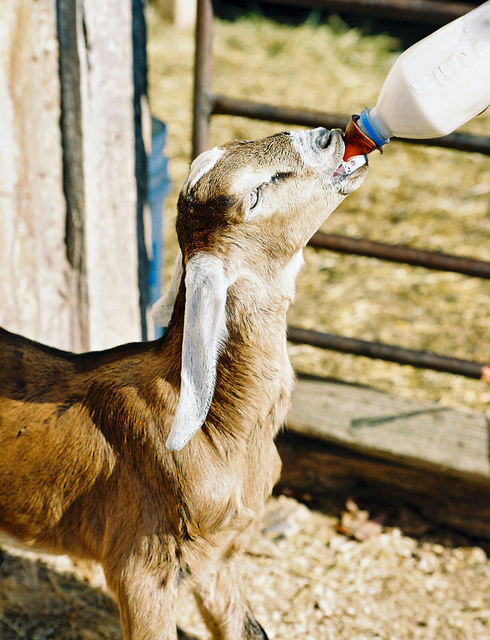
Even though the female goat is responsible for feeding her baby, there may be times where you have to get involved.
Sometimes the mother may be too sick and will not be able to take care of their offspring.
This is where you come in. The kids are required to be fed four times every day.
After 10 days, you only feed them three times a day. After 8 weeks, they get fed only twice a day.
Once they have been weaned, they get one bottle.
Since this will be new for you, consult with the veterinarian to see what formula you should feed them.
Warm up the milk and put it in the bottle. You will also need towels while you’re feeding the baby pygmy goat.
Rub a tiny bit of milk on the nipple of the bottle. You want the baby goat to know that it’s food for them to eat.
Since the babies are small, you will have to kneel or sit down on the ground.
The baby goat’s eyes should be covered. Work on opening their mouth if it is closed.
When placing the nipple in their mouth, hold their tongue down. Get your thumb out of the way.
As you are feeding the baby goat, keep the bottle tilted upwards.
You may have drips of milk around the area. Use the towels to get it up.
Eventually, the baby goat will realize that there is nourishment in the bottle and you won’t have to resort to covering their eyes anymore.
After three weeks, the baby goat will start on solid foods.
Here are some things to look for when you are feeding goat kids:
· They goats should always stand straight with their head up. If they don’t they are subject to get colic or develop other health issues.
· If the goat is not hungry, don’t force them to eat.
There are some other things of concern that you should contact your veterinarian about if you see them happening with your goat kid:
· Stops being active
· Hunching
· Drooping
· Contracts diarrhea
· They get wet
· High temperature
· Weight loss
· Coat looks bad
· Lice
· Worms
Goat Diseases to be Aware of

There are various diseases that goats will contract. Some of these diseases come from viruses, parasites and bacteria.
The diagnosis of the diseases will vary. However, some of these diseases may be similar and can be difficult to pinpoint.
Treatment is imminent in order to get them well very quickly.
There is a part that the farmer is required to play as far as getting their goats back to health.
A lot of times, these diseases can be prevented if the farmer takes preventive steps to keep their goat healthy.
Here are some of the diseases that goats deal with:
Abortion
Abortion in goats can happen between the 6th – 8th week of a doe’s pregnancy.
It can be caused by drinking water that has salmonella. The female goat can receive treatment from a veterinarian.
Anorexia
Can be caused by a lack of appetite.
Arthritis
Arthritis in a goat (baby) can be an infection in the navel.
There is also arthritis that happens after birth, due to neglect of sufficient vitamins and minerals.
Anthrax
The goat gets a high temperature and doesn’t have an appetite. They may only survive for a day.
Keep the goat away from everyone. For the remaining goats, they should be vaccinated.
Bronchitis
If the goat gets a lung worm infection, they can get bronchitis.
Get rid of the dust in the feed by putting more water in their mixture (regular or molasses water)
Bloat
Eating Lucerne hay can cause the goat to bloat. It will urinate a lot, walk funny and stomp their feet in irritation.
Use hay that is dry when you are giving them fresh legumes. This can prevent them from bloat in the future.
You can also put a little peanut oil on the feed.
Chlamydiosis
The symptoms for this are diarrhea and pneumonia. If the female goat is pregnant, they may lose their unborn child.
If the child is born, they may contract arthritis. The goat can be treated with penicillin.
Coccdiosis
The goat will have low blood, diarrhea and feel week. If they are baby goats, they could die.
They will need to be examined by a veterinarian.
Dermatitis
There are different kinds of this disease:
· Labial dermatitis – when milk residue remains on the mouth of kids that are pan fed, the skin gets hard and starts to crack. Their face looks disfigured. This can be treated with a cream.
· Labial and interdigital dermatitis – this happens when a goat eats plants such as ragwort Azaleas or they are attacked by mites. To treat this, use lanoline or petroleum jelly.
· Allergic dermatitis – this happens when a goat gets bitten by wasps or mosquitoes. This can be treated with a protective cream.
Eye Illnesses
· Conjunctivitis – this happens when a goat’s eyes come in contact with grass, seeds, and thorns.
The closer that they get to the cornea, the greater chance there is of contracting this.
The eye area gets red and swollen. The affected area can be treated by using a saline solution.
· Pink eye – this is a contagious disease. You may see a discharge coming from the goat’s eye.
Wash the affected area with saline water. Use aerosol drops (2 drops) twice a day.
Foot and Mouth Disease
This disease affects young goats and adult goats. It affects the tongue, lips, cheeks and other oral areas.
The adult goats look lethargic; the kids may not survive the disease.
Keep them away from everyone else and get the rest of them vaccinated.
For the ones who have the disease, wash their mouth using a mild disinfectant.
Foot Rot
This disease is contagious. It deals with various bacteria. The foot gets inflamed and it is moist.
They turn red and start losing hair between their toes. The infection can mess up the horn of the foot.
This can cause the goat to lose weight.
Goat Pox
The goat will have a fever and feel congested. If it’s a baby goat, they will have a high temperature as well.
They could also have lesions on their skin, but they usually don’t live long enough for that to happen.
Keep them away from everyone else.
Wash the skin lesions using hydrogen peroxide. And warm water.
Use antibiotic cream to keep out infection.
Hemorrhagic Septicemia
The goat will have difficult time breathing, a high fever, coughing and they may succumb to this disease.
Treatment involves being vaccinated.
Hoof Trimming
In order to prevent the hooves to grow differently, they must be trimmed.
Having them grow any kind of way will add pressure on the goat’s legs.
The pressure can lead to pain which would make it difficult for them to walk.
If some of the hooves have curled up, mud and other stuff can get inside.
This can cause foot rot disease. Trimming is important so that the toe and the heel of the goat can be placed in proportion with one another.
Make a schedule to have your goat’s hooves trimmed every 90 days.
To learn more about the comprehensive goat care needs, check out the "Goat Crazy" raising goats manual below
Goat Keeping Essentials for Goat Care

· Always keep a clean and cool supply of water
· Always keep a clean and fresh supply of bedding; when it gets soiled, change it immediately
· Keep a set of hoof clippers and a brush for regular foot maintenance
· Always keep a fresh supply of hay for them to eat
· Keep healthy treats on hand, such as fruit or vegetable peelings, corn, black oil sunflower seeds and various grains
· Make sure that the area for your goat is secured and fenced-in at all times; this can prevent them from running away as well as keeping out predators
Taking care of goats can be interesting, fun and profitable.
There are many people who love animals, but never thought about raising and taking care of a goat.
You have to be in it for the long haul in order for you to make that commitment.
Goats love company and they will always need some company (besides you) to keep them going.
If this is the life for you, then by all means, go for it.
To learn how to keep goats healthy, happy and productive, you need a lot more information than this!!!
My book is the ULTIMATE guide for how to keep goats, whether they are pets or you are goat farming for profit.
Read the details of what the goat book contains below, and remember, you can buy it direct from here with the bonus recipe book when you get the pdf ebook download, or you can buy it as a Printed Book on Amazon who will post it to you, or as a Kindle download for your tablet or phone from Amazon...
So take your pick of the book format - I know you will be absolutely delighted with the massive amount of valuable information you will learn about keeping goats!!
Incredible Guide for Keeping Goats Reveals:
How To Have the Healthiest, Best Producing,
Longest Living Goats in the Land.
You'll soon have such amazing goats your neighbours will be scratching their heads in wonder... and be asking "how?"
Dear Fellow Goat Lover,
Finally, a breakthrough new book, just for people like you (and me) who are enthusiastic about all the different breeds of goats.
A book written by someone who knows, and has years of experience keeping goats. Whether you own goats as pets or for the incredible products that you can get out of them... this book about the best practices for keeping goats is definitely for you.
By the time you've finished reading and have been engrossed in this 90 Page eBook manual you'll be an expert. There won't be a thing you don't know about the incredible world of keeping goats.
You'll avoid all the pain of simple mistakes most new goat farmers make along the way. Instead you can, in just 90 seconds, jump ahead of the pack with crucial knowledge that puts you in the driver's seat.
You will feel so much more secure and confident knowing that you are better prepared to care for your pet goat, or even to start a goat farm. Now you can anticipate the future expecting to experience more fun and profit than ever before for you and your whole family.
"Such an amazing eBook manual - it gave me easy to follow information, which until now I couldn't find anywhere else. I've gone from skinny unhappy, poor milk producing goats, to the exact opposite.
A happy healthy flock in record time. A big thank you to the “Goat Crazy” Team from myself and my goats"
Mary Peters - Goat Owner, Louisiana
You won't find this information about keeping goats anywhere else. Not at the pet store. Or at the library. This eBook is EXCLUSIVE to us !
I promise this e-book is set to revolutionize the way people look at the humble goat. (Don't be surprised if your friends keep asking to borrow this book off you!)
Goat Crazy is jam packed with insight and absolutely necessary for goat keeping success - it's like a backstage pass into the secret world of healthy and profitable goats. You'll uncover the truth you need to know. In as little as 90 seconds to download this .pdf ebook.
You could be armed with a wealth of information , from how to recognise and treat illnesses, to knowing how to buy the "perfect" goat. This means you can sit back and enjoy every aspect of keeping goats without any of the worries! A
nd for the first time in all the years this best seller ebook has been available from here, you can now also buy the book as a Kindle download from Amazon, or buy it as a Printed book, posted to your home from Amazon online.
These are not theories but proven strategies,
from a lifetime's experience keeping goats
that will work for you.
"I really learned a lot in this
book…. Far more than I will ever need to take care of Sherry (my pet
angora goat), but its great to know that I am now *prepared* for
anything that may happen.
I especially feel more confident in keeping an eye out for any health problems and to prevent most of them with the right goatkeeping care. It’s all in the book – I highly recommend it to anyone thinking of keeping a goat."
Gunnar Petersen- Goat Owner, Maryborough
Have special sneak peek at what goatkeeping gems you'll discover in “Goat Crazy”:

The 62 Horribly Poisonous Plants to your Goats and how to avoid them.
The Absolute Best Ways to house and keep your Goat happy and healthy.
How to make the Milking Cycle work to your advantage.
Understand the 2 Crucial Sections of a dairy operation so you can sleep easy at night.
You'll Know The 7 Lifesaving Questions you must ask before keeping goats.
Discover the 3 different types of Fences that will save you precious time and money.
Goats and their wool - you'll understand every type and what they're used for...and how to make money from their wool.
You will become an expert on the differences between a "dry yearling, milking yearling and aged doe".
Let me show you which of these dairy goats best suits you
In great detail I cover: The 4 detailed areas of a Meat Operation and how to create one that guarantee you success every time.
You'll know exactly what to do if any of the Most Common types of illness' and injury occur.
Make no mistake, these 20 goat keeping secrets alone will save you
thousands of dollars, not to mention how much happier your goats will
be.
Revealed Is How to Create the Ultimate Birthing kit - This is a must for anyone serious about Keeping Goats!
Find out how to protect your precious flock of kids during the Danger period of Birth to 2 Months.
7 ways to Cure Goat Pinkeye, plus a never before shown 8th Simple, Safe and Effective way to cure your goat yourself.
That's right I'll show you how to avoid that expensive Vet call out bill. Your Goat will thank you when you know and understand How To Deal with any of the problems you may encounter during your goat’s pregnancy and birthing.
And this is just the tip of the iceberg.
In the 90 pages of this eBook there is so much more about keeping goats to discover and be delighted by!
"Goat Crazy is very informative and thorough in all aspects of goat owning. I especially found the information on goat training, feeding and diseases to be helpful. If we had this information about keeping goats before we got our first two goats, we wouldn't have made the mistakes that we did."
Laura Shorney - Goat Owner, Australia
You may be wondering Why This eBook Was Written?
For quite a few years there was simple one page web site that had basic online goat keeping information and a place where people could ask the tough questions such as:
How do you know and learn to know what is wrong with your Goat?
Why does it act the way that it does and what does it mean?
What is the best medication for Pink-Eye?
Can goats be raised for wool?
When do you milk them?
My goat won't cooperate.
What viruses can goats get?
Which vaccines should I give to baby goats?
How much milk will a good nanny give at a milking?
How do I treat a nursing goat with sore udders and still be safe for a baby to suckle?
Are they friendly when small and will they bond with those who take care of them?
What's the most nutrient-rich plant, grass, or ground cover to plant inside an enclosure for goats?
Is it safe to de-worm a pregnant doe?
Some goats are known for giving birth to more than one kid. Is there a way to tell if a nanny will give birth to multiple kids BEFORE you buy her?
What is the proper care for keeping goats. I am new to this and would like to know their needs and how to care for them properly
Do goats need more than water and a field of grass, weeds and trees to live on?
What are the signs of parturition?
How much area does a Goat require to be Happy/Healthy and do they prefer grassy areas or enclosed areas at night?
What is a good milking goat and how do they compare to the adorable angoras personality and handling wise.
Are the goats, lactose intolerant?
Is it easy to raise goats? Do they require much space?
What kind of fence do you need for Goats in a Large place?
How long do they stay in heat?
Can goats be in the same pen as sheep and chickens?
What is another name for a Swiss Goat?
Do I need to separate my doe from my buck before birth?
What are the most toxic plants?
How is the best way to wean babies and at what age?
We're starting to wean at about 6 weeks depending on the baby's size. What is the norm?
How long do you need to wait to drink the milk after de worming?
If a baby goat is called a "Kid", what is an old goat called?
I have a 2 day old kid female. Her and her sister were born on Sunday. This little kid is having a problem with its rear leg almost like its in the knee area not the hip area. What can cause this?
Why wont my baby boer goat nurse. I assume she is around 3 to 10 days old the umbilical cord is still attached. I have tried all I know any suggestions?
My goat had her first kid 4 days ago
and today I noticed that one of her nipples is swollen and a blackish
colour and seems to be leaking. What should I do?
Castration: At what age should this happen?
What is a whether goat?
Exactly how do goats mate?
Which goat makes the ideal pet for children and have all goats got horns?
What to do when a goat has a kid and doesn't take care of it and how do I take care of it?
This does sound silly but I really like goat's milk, cheese, etc (am allergic to cow's milk) and we might be buying a house with land. I would quite like to keep a goat never done anything like that before - is it realistic?
We are just starting out in the goat business. We bought a myotonic male 3 months old and 2 pygmy females just weaned from their mom.
Can you tell me about breeding goats. Some say you need two males and separate the males from females. Got any information for new beginners?
And how often do you worm them and what kind of medicine do you use?
Can my children hold the baby goats after they are born, or how early can they be handled?
What is involved in caring for a
baby (1-2 week old) goat? (i.e. how often must they be fed a day, how
long do they need to be fed on a bottle, when do they go to other types
of food...)
Guide lines to start a dairy goat operation and market the milk.
This is about the goats that are like dwarfs, is it possible to house break them? also can you have them in most city limits?
How long do you feed a baby goat for and how do you transition it to just eating grass?
What is the best food to feed a rescue goat that is starving and very, very skinny?
What are the different breeds (need pictures); need info on each breed's temperament, use (dairy or no), size, color variations, hair length, type, history of breed, country of origin, etc., etc.
I have had two billys lose their hair around the top of their hooves. It don't seem to bother them, but it gets really red and raw looking. What should I do to remedy this problem?
How to feed a goat
How will I know when to trim their
hooves and how much to trim? I know proper hoof care is very important, I
want to learn to do this myself, I just don't want to clip them to
short or leave them to long.
I just got a baby goat how long should it be bottle fed?
What to do with a caked udder?
How do you raise goats?

I have a newborn billygoat and it’s joints are too weak to support it without help holding it up to nurse. What can be done for it? What is wrong?
With mastitis in the goats udder, what is the blunt solution? Is the goat going to die, she just had her babies, what happens to them? And what is the best treatment?
How to you cure an urinary tract infection?
What treats can they eat?
Do Goats get colds?
What do they do all day when I'm not playing with them?
How do you catch Goats?
How can you tell how old a goat is?
What kind of goat would be good to have for a family pet and keep the weeds eaten in the back yard?
Do they get along well with other animals? Such as horses, sheep, cows and so on.
Is there any way to effectively
socialize goats that have been neglected or are just plain nasty and
mean?
What's the best way to quickly tell the difference between goats that are well socialized and those that aren't when purchasing them?
What do they eat? How much does a goat cost per year?
What is required to keep goats?
Can you keep a goat in a backyard as a pet - if so what type are best suited?
How do you train a goat not to nibble on your clothes while working with him. They seem to want to sample your hair, clothing, eye glasses, etc. Do you tell the goat "no" and push it away?
How do you discipline it, without scaring it, to get it to mind you. What is your best advise to get started raising meat goats.
How do you pick out the good from the bad? what do you look for?
Things a novice needs to know.
What are female goats called?
Is antibiotic effective for foot rot and which antibiotic is MOST effective?
What is the best nutrition for goats?
What should a beginner know before buying their first dairy goat?
Tips on how to purchase your first goat.
How long do goats usually live?
How do I care for their hooves and teeth?
Why do goats have that little beard?
How do I get started in raising, milking, and housing Goats?
Do you have to milk all female goats?
Do they live in trees in any countries?
What kind of weeds will goats not eat?
Is it true that all male goats urinate on themselves and carry a bad odor? If so, why?
What is the best procedure for trimming hoofs? And how often is this required?
I know nothing about keeping goats, but am in love with the idea, how do I get started?
I have a goat with horns which I
find intimidating. How can I make sure the animal does not injure me
with them? And how can I ensure gentle behaviour from the goat?
I would like to buy some goats for my future farm. How much personal care do goats need?
How do you look after them and how can you get them tame?
How often can you breed a goat?
What is the best way to housetrain a Pygmy goat?
I am keeping a goat, I sometimes look at him wondering if he is lonely. Do goats need company with its own kind?
What is encephalitis in Goats?
How are you supposed to use a drench gun to give medication?
How to tell the age of a goat?
What is the Buck to Nanny breeding ratio?
Pictures and instructions for debudding kid goats with rubber bands. What is the best treatment for scours in goats?
What is the difference between dwarf and billy?
And we would also like to know which kind is the most manageable, and smallest.
How many times a year should your goat have kids. We have our first crop and are wondering if we should breed for a second crop.
Goat wormers are few and far apart and it seem that the worms become resistant.
What are the know herbal remedies? Or any home cure. Yrs. ago there was no big drug companies and goats made it alright I am sure.
What type of grass pasture is the best for grazing goats, both young and old?
Training.
How many goats per acre can you "run"?
Fencing, housing and marketing.
What is the best dewormer(s) to use and how often should a goat be dewormed?
How do you take care of foot rot? We have had so much rain that my goats seem to be susceptible.
It was the sheer volume of questions about keeping goats and demand from desperate fellow goat owners that has lead to this ebook.
Be Warned! This is not your average ebook filled with fluff and wordy nonsense.
It has straight to the point, hard hitting facts and information that answers in detail every possible question about keeping goats that you may have.
My aim is to have perfect, happy, (in fact delighted) goat owners and goats. It's for this reason that I'm prepared to offer such a generous gift and provide a no B.S Ironclad Guarantee.
If for Any reason you're not happy - you can get your money back... that's right - you're covered by my no risk, 100% Money Back Guarantee.
Make no mistake "Goat Crazy" is a groundbreaking guide about keeping goats and it's the result of years and years of painstaking research compiled all into a single book, just for your convenience.
It is truly a one-of-a-kind information that you won't find in any bookstore or library.
And of course the best part is...
You Can Be Reading It 90 Seconds from Now!
In the past, others have paid up to a ridiculous $89.99 for books about keeping goats of poorer standard. (I still kick myself for not doing this book sooner - Sorry!)
You can have the benefit of this truly great e-book for a tiny $9.90
That's a whopping $60 less than anything the competition has to offer!
And that's not all... When you say "Yes",
You'll be Given a Free Recipe eBook (valued at $37.77) as a special introductory gift just for you.
"Your Bonus eBook of recipes using goat cheese or cooking goat meat is Awesome and so easy to read and understand...Again The eBook is Outstanding."
Mary E. Jones - Vet and Goat Owner, Kentucky USA
And the most exciting bit about "Goat Crazy" is that you can choose a downloadable E-book or a Kindle download format - This means that the moment you place your secure order, you'll have INSTANT ACCESS to it.
OR - you can order a printed paperback from Amazon to be delivered to your door.
If like me you like to read your book on paper, the good news is that the "Goat Crazy" Adobe .pdf ebook IS PRINT ENABLE APPROVED, so once you download this ebook to your computer, you just click your computer's PRINT button, and then store the printed pages of the book in a clip folder like I do!
Otherwise, just buy the Printed Book from Amazon online at the links below here!
But if you buy "Goat Crazy" e-book .pdf version direct from here today, then best of all...
"You Get My Goat Recipe eBook Worth $37.77 absolutely FREE!"
"Goats: Tantalizing Recipes" In this special compilation of recipes, you'll learn all the different types of meals you could ever possibly want to know:
- Over 15 Goat Meat Recipes including:
- Jamaican Curried Goat
- Cabrito Stew
-
Goat With Vermicelli
Over 10 Delicious Goat Milk Recipes including:
- Chocolate Fudge
- Pumpkin Pie
- Chevre Dessert ...and that's just a taste of the amazing meals you'll be able to create with “Goats: Tantalizing Recipes”.
In just a couple of minutes from now, you could download the ebook and bonus cookbook for only $9.90.
That's less than what it costs to eat dinner at a decent restaurant or buy a couple of gallons of petrol. Think about the difference a happy healthy goat will mean to your life and bank balance.
And this is the best place you can buy this ebook – it is written by us and EXCLUSIVE to us … we don’t let just anyone offer this book!
For sure $9.90 is absolute peanuts compared to the $27.00 others have had to pay - and you'd agree... it's a small price to pay to own the worlds best cared for happy, healthy and long living Goats!
And that's just what you'll be able to have and be once you put this unique goat keeping and farming book to work for you.
If After Using the vast Amount of Information that You'll learn from my eBook, You Don't Have a Healthier, Better Producing and Happier Goat, You Get a 100% No-Hassle money back Refund! (But the ebook is yours to keep no matter what!)
If you aren't totally thrilled with
"Goat Crazy" for any reason what-so-ever then just send me an email and
I'll give you a 100% refund. All I ask in return, is you let me know why
you were unhappy so I can fix it for the next person, (if there is
anything I can do).
And I'll let you keep "Goat Crazy" Plus the recipe book, as a way of saying thanks for helping me out!
That's about as fair as it gets!
There are no questions asked, no 'weird hidden clauses' and no funny business. Either you absolutely love it or simply get a refund AND keep it FREE. Wouldn't it be great if everything came with this kind of guarantee, it would make my life easier?
With this insane 'No-Hassle' Guarantee, you have absolutely nothing to risk...and everything to Gain!
We are certain that you'll be thrilled with "Goat Crazy"... and you'll be ecstatic by how much you and your goats will get out of it – all for just $9.90
NOTE** The Bonus book is only available with this pdf ebook download - the Amazon book versions do not include the Bonus recipe book **
Click the buy button below to get instant access right now via secure PayPal – even if you don’t have an account with PayPal, you can still use your credit card or account to pay here!
More Resources for How to Keep Goats
Below here are more pages of raising goats tips for you to check out, and you are welcome to add your tips and articles to this section as well, just post your article in the submission box below.
More Tips for How To Do It Yourself: Pet Care
Do you have a Pet Care tip you want to contribute here? Share it!
Keeping goats is a business with pleasure, as they are lovely animals.
Learn more about goat care and raising goats, like this subject of how to keep goats by visiting the HOME PAGE and selecting from the range of pets I have written about.

"Power Tips" magazine is back!
You Get A Free Complete Self Help Report delivered to your email box every edition, plus you get a free PLR article and other great gifts!
SUBSCRIBE BELOW ... I promise you will want to USE what you learn!
I really want to know what you think of this site, this page, and to hear your tips or suggestions about it.
So please share your story or simply add a Comment in the comment box.
If you feel that the information on this page has been useful to you please give it a Like or share it with your friends - thanks!!
"You are a life Saver!!
I recently discovered this site and I can tell you that my life has not been the same. I now come here EVERYDAY and spend at least 1 hour.
I used to spend that time browsing online fashion and beauty
magazine which just means that I spend more. Now I have replaced that
habit with coming here.
In future I will think about contributing articles as well. Thank you! Thank you!! Thank you!!! and God bless"
Contact Us | About Us | Terms of Use | Privacy Policy | FAQ | Testimonials
Amazon and the Amazon logo are trademarks of Amazon.com, Inc. or its affiliates. As an Amazon Associate I earn from qualifying purchases. Product prices and availability are accurate as of the date/time
indicated and are subject to change. Any price and availability
information displayed on [relevant Amazon Site(s), as applicable] at the
time of purchase will apply to the purchase of this product.









New! Comments
Have your say about what you just read! Leave me a comment in the box below.